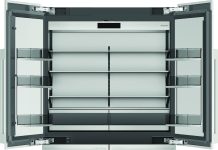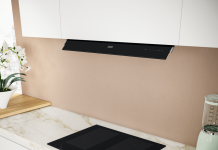Cookers are increasingly diffused, also thanks to an attentive and constant marketing that promises great cuisine performances also to those who are approaching cooking for the first time.
by Vivien Reimbelli and Valentina Zambello
Actually, everybody’s dream: a perfect machine able to churn out automatically delicious delicacies without intervening manually, apart from simply provisioning the appliance with food, and taking care of other activities while, almost wonderfully, ingredients turn into recipes worthy of a star Chef.
Is it just so? Not exactly, but the preliminary conditions are very interesting, especially in virtue of electronics that has improved performances with more and more performing electronic cards and processors able to manage complex management algorithms of the various cooking phases, acting on time/temperature parameters but also on the rotation speed of accessories according to the chosen dish.
Safe result?
As anticipated, the most interesting aspect is the possibility of operating in “fire and forget” mode and the appliances at stake generally quite comply with this promise, even if with sometimes erratic results. All springs from the difficulty of managing high temperatures, both in terms of resistance performances and of overcooking danger, leading to the choice of a more prudential approach that, if one hand avoids the risks of excessive browning of foods under cooking, on the other hand the so called caramelization, that is to say the surface browning that keeps juices inside the food and improves its taste.
Excellent, therefore, the preparations like soups, very good stews and all cooking types carried out at moderate temperature, less interesting on the contrary the results in cooking providing for a food browning.
The possibility of mixing and blending is useful especially in cooking providing for the transformation of the dish into mash, thus avoiding uncomfortable transfers between pots and blender.
The various typologies
The essential difference resides in the shape of the pot, which can have shapes ranging from the traditional saucepan to more vertical truncated-cone shapes.
 The saucepan shape, that’s to say lower and larger, is more suitable for cooking but less performing in the actions of cutter blade activation, vice versa those with narrow and elongated shape, more resembling a blender glass, will provide more variable results in cooking but they excel in mixtures and in post-baking processing by means of the blade.
The saucepan shape, that’s to say lower and larger, is more suitable for cooking but less performing in the actions of cutter blade activation, vice versa those with narrow and elongated shape, more resembling a blender glass, will provide more variable results in cooking but they excel in mixtures and in post-baking processing by means of the blade.
Sizes make the difference, too, with pots that range from the capacity of 1 litre to 2.5 litres. Not only small pots will be insufficient for a numerous family but the small contact surface with food will generate an inferior cooking result in comparison with a larger surface, increasing the tendency “to boil” foods instead of browning them, with bigger loss of liquids and a less crispy and tasty result.
Interface and controls
The control architecture generally includes the presence of a display that visualizes the operation information and a series of keys that activate manual and automatic functions.
Displays are sometimes crowded with information and they do not grant immediate readability. In automatic functions, in particular, even if very valuable from the aesthetic point of view and very “hi-tech”, you lose the immediacy that facilitates the use and, until you have become fully acquainted with the appliance, you often have to repeat configuration operations, creating a bit of confusion to users.
In addition, their lighting, under determinate light conditions, tends to “knead” the key characters and to make them scarcely visible.
 This is an open debate between designers and users: the first tend to adopt an essentially aesthetic approach in the interface implementation while the second call for better clarity that starts from the display simplification.
This is an open debate between designers and users: the first tend to adopt an essentially aesthetic approach in the interface implementation while the second call for better clarity that starts from the display simplification.
The use of suffixes like the various P1 or similar to indicate programmes, compels to a frequent reading of use manuals, too.
Concerning this, it would be advisable to introduce a drop-down menu into FAQ for an immediate reading directly in the appliance.
The character size, finally, is not always suitable for a comfortable reading, creating difficulties to those not relying on a perfect sight. Better, then, few information at a time but displayed in clear and readable way.
Finally, the long-standing problem of touch controls, aesthetically valuable and easy to clean, which, however, in the daily use by not perfectly clean hands, generate some activation troubles. Excellent instead the solution of the sound warning coupled with keys, which acoustically informs about the occurred activation and frees from the doubt of having, or not, started the selected function.
The same signal informs about the change between an operation modality and another in case of automatic functions providing for different modalities but, also in this case, it would be preferable that the display clearly advised what phase we have reached, without using codes of difficult understanding but with a clear and simple …writing! Also in this eventuality we avoid that the operator must turn to the instruction manual, in particular when we have to suspend cooking for some reasons (the usual unexpected telephone call?) and at the restart time we do not know exactly what stage we have reached and how to proceed to accomplish the action.
Safety and operation
Being some parts in motion, like blades and accessories to mix, appliances operate only with closed cover. However, in cooking processes, this prevents users from seeing what actually happens inside appliances and can be one of the reasons for the prudential choice of not reaching high cooking temperatures, not easily managed in fully automatic manner (the range goes from 100°C to 130°C). Consequently, to give a peek to our meal and to verify its state, it is necessary to stop the machine and to remove the cover. On the contrary, it would be useful to enable the appliance to recognize the inserted tool and, if you were using the mixing blade and not a cutting blade, it would be useful to let the machine operate also without cover. Just imagine the cooking of a pasta or a risotto: most people prefer deciding the right cooking level and, simply changing the raw material, cooking parameters can unavoidably vary, thing that the appliance cannot do in automatic modality.
necessary to stop the machine and to remove the cover. On the contrary, it would be useful to enable the appliance to recognize the inserted tool and, if you were using the mixing blade and not a cutting blade, it would be useful to let the machine operate also without cover. Just imagine the cooking of a pasta or a risotto: most people prefer deciding the right cooking level and, simply changing the raw material, cooking parameters can unavoidably vary, thing that the appliance cannot do in automatic modality.
In a specimen, they tried to solve partially the problem by making the cover transparent, solution that, even if partial, at least allows carrying out a visual monitoring of the cooking state and, in case of mixtures, it permits verifying the correct mixing. Let us imagine the preparation of a mayonnaise without the possibility of verifying whether it has curdled or not.
The different functions
The various appliances are quite similar one another in terms of functions, which can be generally summarized into:
– Mixing
– Cooking
– Blending
– Steam cooking
Mixtures can be of two types: fluid-soft (cakes, creams) and hard (bread, pizza). If there are no problems for the first ones, we see the limits of some of these appliances in the second ones. The limit is represented by the motor force that operates the mixing blade and sometimes this is insufficient for hard mixtures, to the extent of locking the rotation with failure risks. Perhaps the use of a spiral accessory, typical of some professional mixers, might solve the problem, enabling also not particularly performing motors to grant a good result.
Cooking typologies are also connected with both the pot shape and the power use. There are machines that exceed 1,500W and others that do not reach 600W. It is clear that the resistance output will be different not so much in the cooking temperature achievement but rather in its operation. It is in fact worth reminding that the food introduction  into the pot corresponds to a temperature decrease, since the same will tend to cool the cavity and, if the cooking temperature recovery will be too slow, the result will be a release of food liquids and its consequent boiling.
into the pot corresponds to a temperature decrease, since the same will tend to cool the cavity and, if the cooking temperature recovery will be too slow, the result will be a release of food liquids and its consequent boiling.
An accurate study of the blade shape is largely the factor that determines the good blending result but there are other elements worth considering. One is certainly the rotation speed of the same: a high speed grants the fine grinding of ingredients, obtaining a velvety cream when necessary, for instance in creams and soups. The other is the pot shape, because low and large pots facilitate cooking but they tend to see the ground ingredients projected on their walls, in particular in case of onions and herbs lightly fried in oil or other, processed in small quantities and without a liquid base that tends to convey the processed product towards the blade.
Steaming sees the use of the standard basket for steam cooker.
Accessories, can we improve them?
These appliances are generally equipped with a series of blades/tools, a cooking pot and a basket for the steam cooking.
There are two different philosophies concerning that: a school of thought privileges the multifunction accessory, limiting the number of accessories to be managed and the need of storing them after their use, the other prefers the creation of tool-blades with specific shape dedicated to a determinate preparation.
Blades are generally made with a synthetic material body that incorporates the metal part.
Everything is fine, apart from the fact that couplings often do not grant the right rigidity, generating some backlashes that, especially in high-speed rotations or in the processing of compact dishes, can lead to precocious wears of accessories and generally reduce the performance quality. It would be preferable that the cover, considering that it remains closed during the food processing, acted also as a guide for the upper part of the rotation shaft of accessories, thus granting better stability to the system.
Steam cookers, as already said, are simply composed by a basket of synthetic or metal material. In some cases, it is equipped with foldable handle for the extraction at the cooking end, in other cases it is not present. The foldable handle will be very hot at the cooking end, being contained in the basket space, and once rotated towards the top, it will expose the operator’s hand to hot steam fumes. It would be perhaps convenient to opt for a separable accessory to be clutched at the extraction time, which might act also as grip and facilitate the basket emptying into a dish.
The product target
Certainly interesting, these appliances can become very useful in the daily practice. The prearrangement for the family’s typical cooking (interesting the part that can be destined to the preparation of babies’ food) and the comfort of making use of an appliance that provides for preparing meals, leaving us free to perform other tasks in the meantime, is very interesting for young couples with children.
Less suitable for gourmets and lovers, who will see some compromises in the appliance and certainly limited performances in the bread-making sector for the said reasons.





